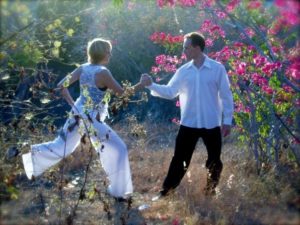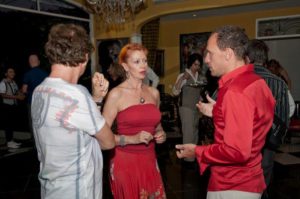Anibal Montenegro is a frequent travelling tango teacher since many years. He tells us about his background and tango vision and his travel experiences. In his suggestinons for tango visitors he recommends to have friends in Buenos Aires. It is fortunate to attend class before the milonga to build your network . Furthermore it is wise to catch the dynamics of Buenos Aires to understand the people’s intention.
Anibal Montenegro, who influenced your dance most , I guess Chicho, no?
No , Chicho is actually the last. The first influence was just dancing for fun in la Viruta and these kind of places.
But then, there was one cultural center , Julian Centeya, close to my house and the teacher there was Hernan Ojeda. This was the first one who changed my dance. Later I jumped to another cultural center, Lola Mora and the teacher there was Dina Martinez. I can say these two teachers make the change in my dance.
The big change to my dance came with the influences of Hernan Ojeda and Dina Martinez.
Then I started to learn from Fernando Galera and Wilma Vega and Julio Balmacera and Corina de la Rosa . The first 2 teachers I had were not the famous ones, but these two teachers made a great impact on my dance. With Hernan, I started to be more seriously about the dance. With Dina, I got all the backgrounds and techniques from Naveira, the explanation and the system, because she was coming from that school.
Chicho was coming much later, when I was ready for his teaching. And Naveira too. Chicho and Naveira both do not live in Buenos Aires , but when they are here , I take classes.
You visited Bali for the first time in 2007 and returned many times after. Sometimes twice a year. Your tango vision left a big footprint in Bali and also on my personal development and with your help we built up the community.
I can say Bali was the first time I came out of Argentina. I planned to stay for 9 weeks. You asked me if I was interested to teach in other cities in Asia as well. And from Bali I went to Kuala Lumpur and Singapore, where you put me in contact with the people.
In Bali, I met Moshlo from Brisbane, who invited me to come to Australia and 2 years later he organized my classes in Brisbane and Byron Bay.

Anibal Montenegro, how do you describe your style of dance and your teaching method, your tango vision , the best?
You know I don’t like to say style like salon , milonguero , nuevo. Because everybody has its own style. I talked with old milongueros about styles. They told me, that it depends on how many people are in the dance floor, how big is the floor, and on the situation. In a crowded place you dance like a milonguero, very small. At the end of the night, the last tango, you can do what ever , you have space.
In my teaching I focus lately in techniques.
I like to give the people some tools and let them decide what style they want to dance.
Of course you need to practice in open and close embrace. In my opinion it’s better to develop your own style and I give tools for this to happen.
My first tango was more like a milonguero, than at Lola Mora I got all the open inspiration, style of Naveira, with Julio I got influences of Salon. My dance is a mix, it depends which person I have in front of me. If we feel connected and have more or less the same background, we can explore . And it depends also on what is happening around, respect the other couples , the circulation .

For my workshops, I devide the program in technique workshops and element workshops.
When I say elements, i mean for example: let’s explore saccadas or : let’s explore voleos , it functions like a tango lab, a couple of days, 3 -4 hrs, just to understand the concept. I focus on techniques but as well combined with the music. I do not teach musiquality workshops, my focus is on techniques and elements but in relation to the music, how to integrate with the music.
Last year we were working on ganchos, for leader and follower. Ganchos are part of the elements you find in tango. In El Beso when it is super crowded on tuesday’s Cachirulo , you will not try ganchos there, but it exists, it is part of the vocabulary of tango.
As a frequent traveling argentine tango teacher from Buenos Aires,who often interact with foreign dancers with many different cultural backgrounds, where do you see the biggest differences in the interpretation of tango?
The big shock was in Asia of course. It was the opposit to my concept here in Buenos Aires. Like we talked before, you have to learn , to listen to know about the place , then you understand what is going on. But my first trip was really a shock for me. In Asia the tango was more like a competition, not like a social dance, a show off , these kind of things.

Asia was a little bit of a shock for me.
I never saw the taxi dancers like i saw in Asia. It was the complete opposite of what I was used to. For me it is social to go to a place and dance with everybody .
In Europe was not a big shock, but in the last year i see dancers, who dance technically amazing, great dissociation, great footwork. From hip downwards it was just crazy, they do it all with absolut perfection. But from hip upwards nothing happened . Just emptyness. I can see an empty performance , with a lot of technical perfection, music , steps whatever, but empty, not transmitting anything. I prefer to do less stuff but more in connection with the partner and with the music. And actually you cannot fake that.
Which advise or can you give to us foreign tangueros in Buenos Aires when we come here to dance. What suggestions for tango visitors do you have ?
I can say that it is always good to have friends in Buenos Aires, friends who can tell you what is going on. In our culture it is a game not always to say the truth, but this is not with the intention that we want to lie. It is a game, it is a seduction..a game all the time.
Have friends in Buenos Aires.
Probably I can see people who come from outside, the first time in tango , they are a bit naive, they believe everything what people say….for example when they say: “oh, we have a good connection” than it is ment to be something different than the connection in the dance. There is a lot of chamuyo, we call it . You say something but you mean something different. It’s good to pay attetnion what is going on. Don’t believe everything.It is always good to have firends in Buenos Aires and to understand what the people say .
Try to catch the dynamics of our culture.
I dont say that you should not trust anybody, just understand what is the dynamic of the talking. Probably it ia a little confusing for people like from Germany or Norway , who go directly, either it is white or black, there are no grays. Here. there are no black and white , it is gray all the time.
Take classes before the Milonga and built your network.
If you come by yourself, not together with friends, I always recommend to take class before the Milonga. It does not matter if the class is good or not, this is not the point. The point is to build your net. You do not feel alone , you meet people who have some expereince or share experiences with you .
When you are in the Milonga try to watch what is going on. That’s what I do when I am traveling.
I like the idea to take classes before the milonga, than you will see which class you like or not. I think the social aspect is very important. Not just the music and technique. Make friends in Buenos Aires and take class befor the milonga. These are my suggestions for tango travellers.
Anibal, Thank you very much for this interview and wishing you happiness and success always.

Check out more in TANGO TALKS :